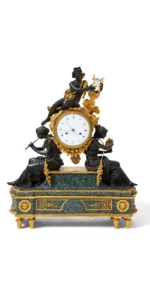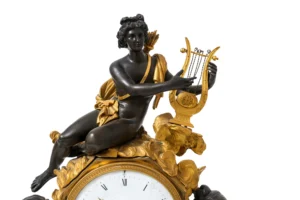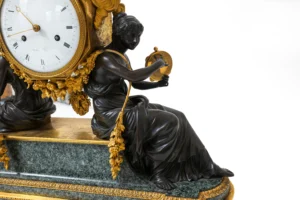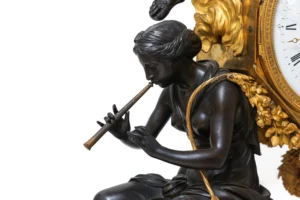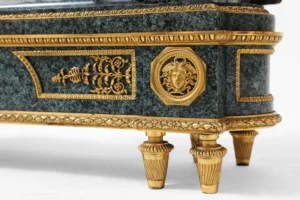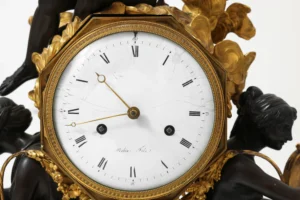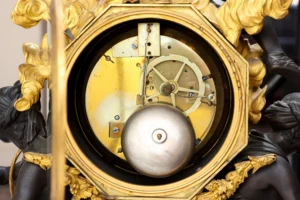Exceptional Neoclassical Mantel Clock in Alsatian Green Porphyry
Attributed to François Rémond (ca. 1747–1812)
Louis XVI period
A superb neoclassical mantel clock crafted in rare green porphyry from the Vosges and mounted with exquisitely chased, patinated, and gilt bronze. It stands on eight gadrooned toupie feet, with a rounded rectangular base framed by a deep cavetto molding.
At its centre, two muses support the clock movement within an octagonal bezel, topped by Apollo seated on a cloud and playing the lyre.
The white enamel dial, signed Robin Fils, features Roman numerals for the hours, Arabic numerals for the quarter hours, and a minute track.
Dimensions: H. 71 cm – W. 56 cm – D. 19 cm
(Damage to the dial)
Thanks to its monumental scale, exceptional execution, and especially the use of rare green Alsatian porphyry, this clock was likely commissioned by a distinguished patron.
The model is generally attributed to the famed bronzier François Rémond. Identical mascarons are seen on the celebrated pendule à l’étude, sold by Daguerre after 1784, one example of which is housed at the Château de Versailles. A white marble version of the same model is also known.
🔍 Historical context:
The late 18th century in France saw a vogue for hardstone-mounted decorative objects—notably in granite, onyx, serpentine, and porphyry.
This trend spurred royal efforts, led by the Menus-Plaisirs under the Duke of Aumont, to locate and exploit local sources to reduce reliance on Italian materials.
The Giromagny quarry in the Vosges, owned by the Duchess of Mazarin, produced a green serpentine often referred to as Alsatian porphyry. Some of this material was used by Pierre Gouthière for vases acquired by Louis XVI in 1782, now in the Louvre Museum.
Parisian dealers such as Jean-Baptiste Feuillet and Jean-Baptiste-Pierre Lebrun promoted these stones in high-profile sales. A 1784 catalogue listed:
“Vases in Alsatian porphyry, granite, and serpentine… some mounted in matte gilt bronze, others ready for gilding, crafted after elegant designs by M. Feuillet.”
